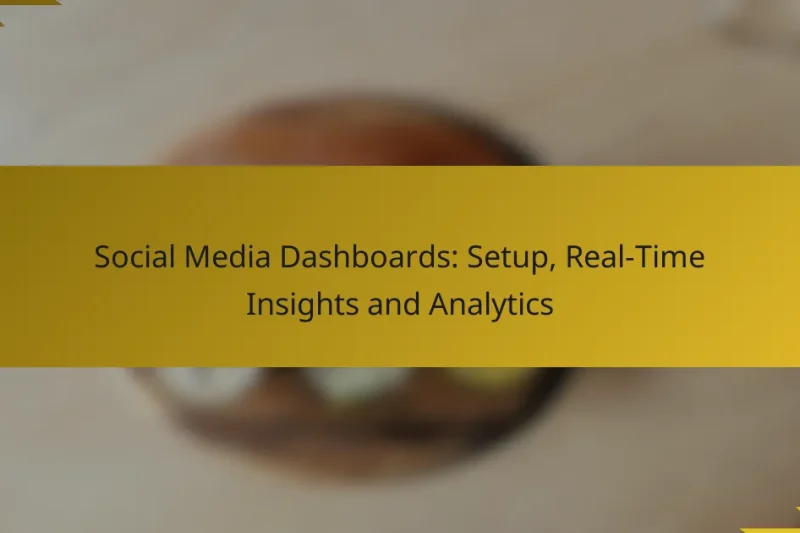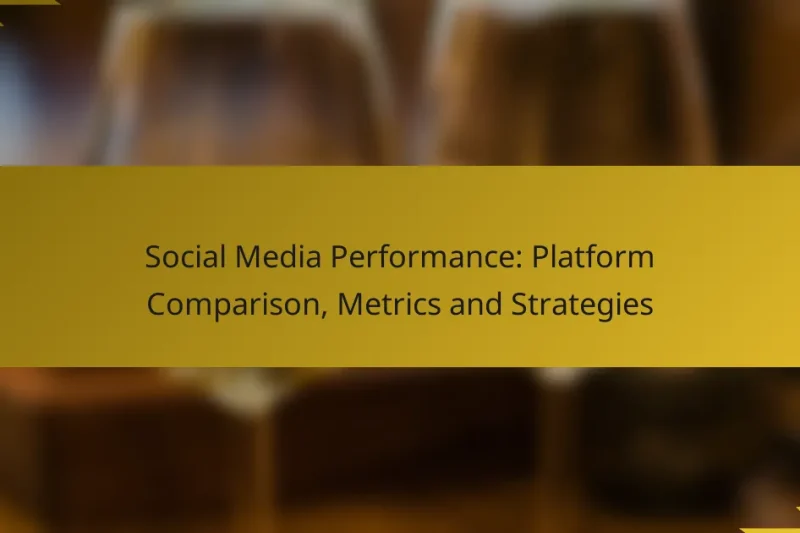Social media dashboards are essential tools for businesses looking to monitor and analyze their online presence … Social Media Dashboards: Setup, Real-Time Insights and AnalyticsRead more
Social Media Marketing for Breweries: Analytics and Performance Tracking
Social media marketing presents a valuable opportunity for breweries to enhance their visibility and connect with customers. By utilizing analytics, breweries can track their performance, refine their strategies, and ultimately drive brand awareness and sales. Understanding the right metrics and tools for performance tracking is essential for maximizing the impact of social media campaigns.
Social Media Performance: Platform Comparison, Metrics and Strategies
In today’s digital landscape, comparing social media platforms is essential for optimizing performance and achieving marketing … Social Media Performance: Platform Comparison, Metrics and StrategiesRead more
How can breweries leverage social media analytics?
Breweries can effectively leverage social media analytics to enhance their marketing strategies and improve customer engagement. By analyzing data related to their social media performance, breweries can make informed decisions that drive brand awareness and sales growth.
Understanding engagement metrics
Engagement metrics, such as likes, shares, comments, and saves, provide insights into how audiences interact with a brewery’s content. High engagement rates indicate that the content resonates well with followers, while low rates may suggest a need for content adjustment. Breweries should regularly monitor these metrics to refine their messaging and improve audience connection.
Consider setting benchmarks based on industry averages to evaluate performance. For instance, a typical engagement rate for breweries might range from 1% to 5% depending on the platform and audience size.
Tracking audience demographics
Understanding audience demographics is crucial for breweries to tailor their marketing efforts. By analyzing data on age, gender, location, and interests, breweries can create targeted campaigns that appeal to specific segments. This information helps in crafting messages that resonate with the intended audience.
Utilize tools like Facebook Insights or Instagram Analytics to gather demographic data. For example, if a brewery discovers a significant portion of its audience is aged 25-34, they can focus on trends and preferences relevant to that age group.
Measuring content performance
Measuring content performance involves assessing how well different types of posts perform over time. This includes evaluating metrics such as reach, impressions, and click-through rates. By identifying which content types generate the most engagement, breweries can optimize their content strategies.
For instance, if video posts consistently outperform static images, breweries should consider increasing their video content production. Regularly reviewing performance data allows for timely adjustments to content strategies.
Utilizing platform-specific tools
Each social media platform offers unique analytics tools that breweries can use to track their performance. For example, Instagram provides insights on story views and profile visits, while Twitter offers engagement rates for tweets. Leveraging these tools helps breweries understand platform-specific audience behavior.
Familiarize yourself with the analytics features of each platform you use. This knowledge enables breweries to tailor their content and posting strategies to maximize engagement on each channel.
Implementing A/B testing
A/B testing allows breweries to compare two versions of a post to determine which performs better. By changing one variable at a time, such as the image or caption, breweries can gain insights into what resonates more with their audience. This method helps refine marketing strategies based on data-driven results.
Start with small tests, such as different call-to-action phrases or post timings, and analyze the results over a few days. This iterative approach can lead to significant improvements in engagement and conversion rates over time.
What are the best social media platforms for breweries?
The best social media platforms for breweries include Facebook, Instagram, Twitter, and LinkedIn. Each platform offers unique advantages for engaging with customers, showcasing products, and building a brand presence.
Facebook for community building
Facebook is ideal for breweries looking to foster a sense of community among local customers. By creating a dedicated page, breweries can share updates, promote events, and interact with patrons through comments and messages.
Utilizing Facebook Groups can further enhance community engagement, allowing fans to connect over shared interests, such as beer tastings or brewery tours. Regularly posting engaging content, like polls or questions, can help maintain active participation.
Instagram for visual storytelling
Instagram excels at visual storytelling, making it perfect for breweries to showcase their products and atmosphere. High-quality images of beer, brewing processes, and events can attract followers and entice potential customers.
Using Instagram Stories and Reels can provide behind-the-scenes glimpses and highlight special promotions. Engaging with users through hashtags and user-generated content can also expand reach and foster a loyal following.
Twitter for real-time engagement
Twitter is effective for real-time engagement, allowing breweries to share quick updates and interact with customers instantly. This platform is perfect for announcing limited releases, events, or promotions as they happen.
Engaging with followers through replies and retweets can enhance brand visibility. Utilizing trending hashtags related to craft beer can also help breweries tap into larger conversations and attract new followers.
LinkedIn for industry networking
LinkedIn serves as a valuable platform for breweries to network within the industry. It allows breweries to connect with suppliers, distributors, and potential business partners, fostering professional relationships.
Sharing industry insights, company news, and achievements can position a brewery as a thought leader. Participating in relevant groups can also provide opportunities for collaboration and knowledge sharing among peers in the craft brewing community.
How to set up performance tracking for brewery campaigns?
Setting up performance tracking for brewery campaigns involves identifying the right metrics and tools to measure the effectiveness of your social media efforts. This process helps you understand audience engagement, campaign reach, and overall return on investment.
Defining key performance indicators (KPIs)
Key performance indicators (KPIs) are essential metrics that help breweries evaluate the success of their social media campaigns. Common KPIs include engagement rates, follower growth, website traffic from social media, and conversion rates for promotions.
When defining KPIs, focus on metrics that align with your business goals. For instance, if increasing brand awareness is a priority, track impressions and reach. If driving sales is the goal, monitor click-through rates and conversions.
Using Google Analytics for social media
Google Analytics is a powerful tool for tracking social media performance, allowing breweries to analyze traffic sources and user behavior. By setting up UTM parameters for social media links, you can gain insights into how visitors interact with your website after coming from social platforms.
Regularly review the “Acquisition” section in Google Analytics to assess which social channels drive the most traffic and conversions. This data can inform your strategy, helping you allocate resources to the most effective platforms.
Integrating social media management tools
Social media management tools streamline performance tracking by consolidating data from multiple platforms into one dashboard. Tools like Hootsuite, Buffer, or Sprout Social can help breweries monitor engagement, schedule posts, and analyze performance metrics efficiently.
When selecting a tool, consider features such as reporting capabilities, ease of use, and integration with Google Analytics. A good tool will provide insights that allow you to adjust your campaigns in real-time, maximizing your social media impact.
What are the challenges in social media marketing for breweries?
Breweries face several challenges in social media marketing, including maintaining a consistent brand image, adapting to frequent algorithm changes, and effectively managing negative feedback. These factors can significantly impact their online presence and customer engagement.
Maintaining consistent branding
Consistent branding is crucial for breweries to establish a recognizable identity across social media platforms. This includes using the same logos, color schemes, and messaging in all posts and interactions. Inconsistencies can confuse potential customers and dilute brand loyalty.
To ensure consistency, breweries should create a brand style guide that outlines visual and verbal elements. Regularly reviewing and updating social media profiles to align with this guide can help maintain a cohesive brand image.
Adapting to algorithm changes
Social media platforms frequently update their algorithms, affecting how content is displayed and engaged with. Breweries must stay informed about these changes to optimize their posts for visibility and engagement. This may involve adjusting posting times, content types, and interaction strategies.
Monitoring analytics can provide insights into what types of content perform best under current algorithms. Engaging with followers through comments and shares can also enhance visibility, as algorithms often favor content with higher interaction rates.
Managing negative feedback
Negative feedback on social media can harm a brewery’s reputation if not handled properly. It’s essential to respond promptly and professionally to complaints or criticism, showing that the brewery values customer input. Ignoring negative comments can lead to further dissatisfaction and damage to the brand.
Establishing a clear protocol for addressing negative feedback can streamline this process. Consider acknowledging the issue publicly and moving the conversation to private messages for resolution. This approach demonstrates accountability and a commitment to customer satisfaction.

